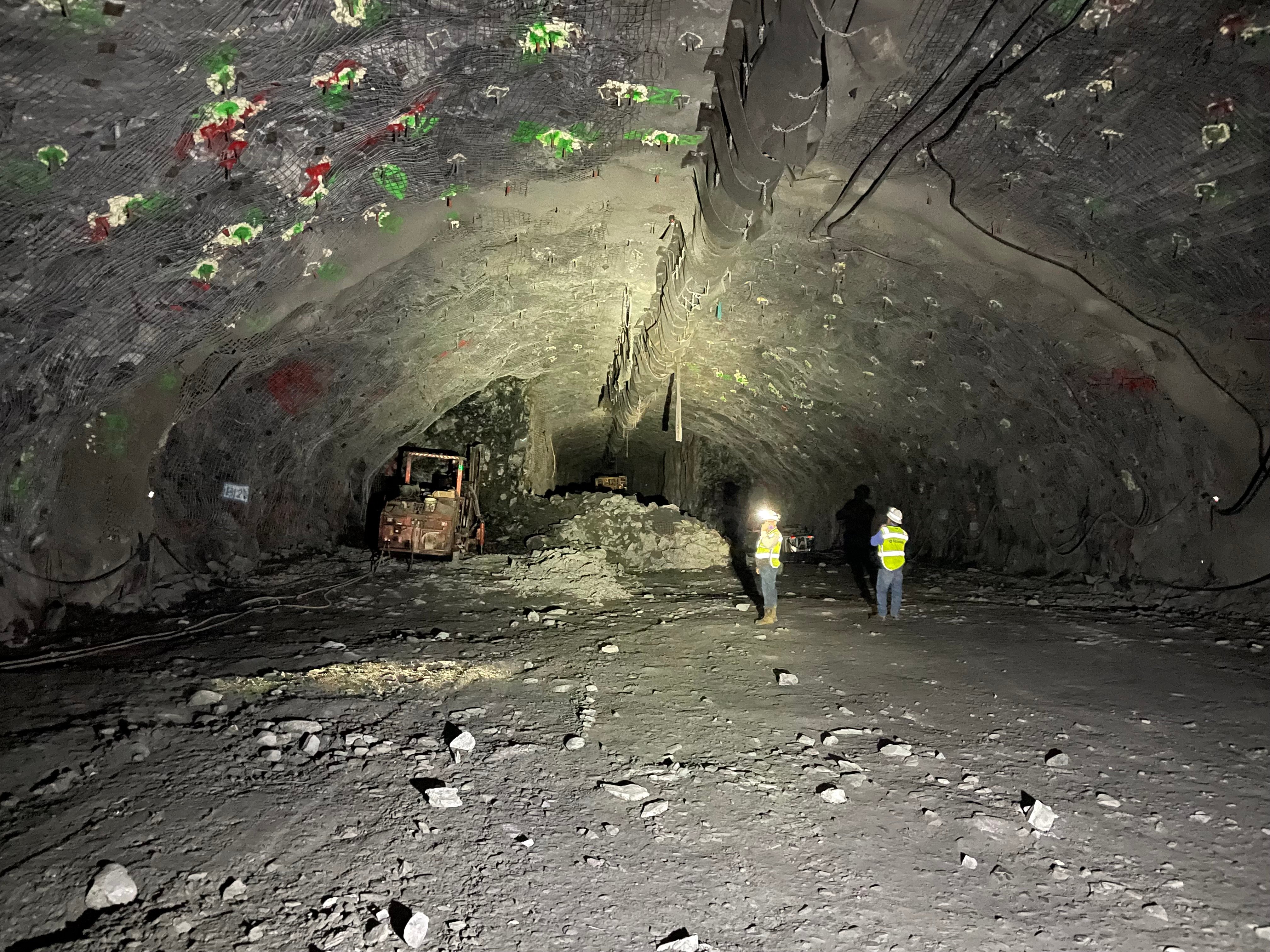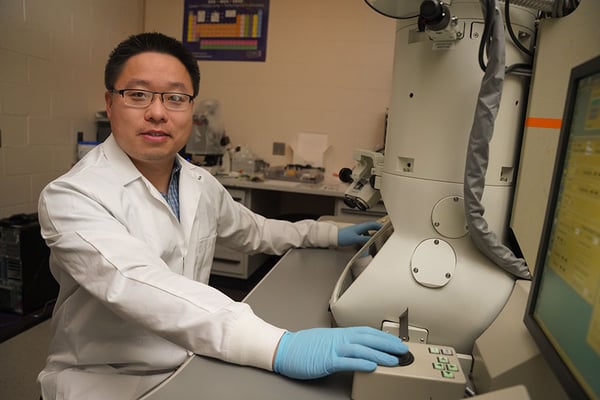There are some things that are hard to really capture in a photo. Take the gargantuan cliffs of Yosemite, the Great Pyramid of Giza, or the sunrise on the Manhattan skyline. A selfie at these spots generally fails to convey their true grandeur and magnitude.
Soon, a new location can be added to this list. The caverns for the Deep Underground Neutrino Experiment (DUNE) being built under the Black Hills of South Dakota at the Sanford Underground Research Facility (SURF).
“The DUNE caverns are mind-bogglingly big. There is no question about it,” says Joshua Willhite (ME 99), one of the engineers leading the DUNE excavation. “It’s impossible to wrap your mind around it without being there. I can show you all the pictures and diagrams, but without actually seeing it, you can’t truly fathom an opening that big underground."
Two of DUNE’s main caverns are seven stories tall, a football field and a half long, and 64 feet wide. A third utility cavern is three stories high, two football fields long, and 64 feet wide. This video helps explain the size of the DUNE caverns. “They are enormous,” says Willhite.
Willhite is an engineer at the U.S. Department of Energy’s Fermi National Accelerator Laboratory, which leads the DUNE project, and a graduate of South Dakota Mines. He is the project manager for the infrastructure being installed for DUNE located in the former Homestake Mine. He notes there are other caverns of similar or larger size on the planet that are closer to the surface. But he says nothing the size of DUNE has ever been done at this depth (4,850 feet below ground).
The engineering challenges of construction this far below the surface are formidable. In a normal construction project, you’d have air to breathe, you’d have enough water, and you’d have room to move heavy equipment and building materials in and excavated rock out. But none of the above is a given in the DUNE construction project.
 Clean air to breathe underground is essential. “Every bit of air that is underground has to come down through one shaft and go back out another shaft, and this requires management of air movement,” says Willhite. At the 4,850 level of SURF, the natural temperature of the surrounding rock walls is 95 degrees, so ventilation for air conditioning is key. “We don’t do anything to generate excess heat underground,” he adds.
Clean air to breathe underground is essential. “Every bit of air that is underground has to come down through one shaft and go back out another shaft, and this requires management of air movement,” says Willhite. At the 4,850 level of SURF, the natural temperature of the surrounding rock walls is 95 degrees, so ventilation for air conditioning is key. “We don’t do anything to generate excess heat underground,” he adds.
Water cannot be taken for granted in the DUNE construction. Take something as simple as installing a bathroom. Pumping water between the surface and the construction site would require almost 2,200 psi of pressure. Engineers like Willhite have broken down the plumbing that supplies water to DUNE into a series of stepped segments to reduce the pressure needed by individual pumps. “It still requires a lot of power to pump water back out. Because of these challenges, we try to limit water use wherever possible,” says Willhite.
Heavy equipment like excavators and front-end loaders and const ruction materials like long steel beams that are normally a part of any construction operation are not so easy to come by at DUNE. “These massive caverns take huge equipment. But we are supplied by mine shafts that are not that much bigger than a normal elevator, and there is no piece of excavation equipment that will fit in an elevator, so we have to disassemble the equipment at the surface and reassemble it at depth,” says Willhite. On top of this, the rock being excavated from these large caverns must be placed back on conveyances and moved to the surface.
ruction materials like long steel beams that are normally a part of any construction operation are not so easy to come by at DUNE. “These massive caverns take huge equipment. But we are supplied by mine shafts that are not that much bigger than a normal elevator, and there is no piece of excavation equipment that will fit in an elevator, so we have to disassemble the equipment at the surface and reassemble it at depth,” says Willhite. On top of this, the rock being excavated from these large caverns must be placed back on conveyances and moved to the surface.
The size and complexity of the DUNE construction are not the only mind-blowing details about the project. The facility, funded by the US Department of Energy, that is being built inside this giant underground expanse is arguably more impressive. DUNE is a true international project that includes 1,000 scientists and engineers from more than 30 countries around the world. DUNE will become the world’s largest physics experiment in the study of neutrinos. The tiny subatomic particles, sometimes called ghost particles, could be a key that helps us understand the origins of the universe. (Learn more about the study of neutrinos in this video.) The large caverns of DUNE will hold massive tanks of liquid argon that will detect the neutrinos coming in from a beam generated at Fermilab in Illinois. Argon liquifies at about 300º below zero Fahrenheit. Willhite will help with the construction of two tanks the size of five-story buildings that will each hold 17,000 tons of -300ºF liquid argon.
“To maintain that temperature, we use a large nitrogen generator and refrigeration system to create liquid nitrogen at -320°F,” says Willhite. The liquid nitrogen will be used to help cool the Argon, he says. “Aside from the ridiculously cold temperature, when these liquids boil, they expand over 700 times their volume. There is nothing inherently hazardous about argon gas except it displaces any oxygen. We have to ensure that this expansion is minimized, controlled, and ventilated properly for worker safety.”
For Willhite, the engineering challenges at DUNE are part of what make it a fulfilling project. “We’re working with world-renowned engineering firms in the design and construction of this project,” he says.
Willhite grew up in the Black Hills and was drawn to engineering as a kid working on cars. He attended South Dakota Mines to study mechanical engineering. “I was good at math, and I liked to work with my hands as a mechanic,” he says. Willhite remembers one professor at Mines in particular, Dr. Dan Dolan, who is now an emeritus faculty member. “The thing with Dr. Dolan is that he wanted you to get into the lab and look at how things are put together. He let you make mistakes and then he helped you understand how to fix them. His excitement for engineering showed in everything he did.”
Willhite left the Black Hills after graduating. “At the time, there were not many engineering jobs in the area,” he says. In 2010 he was invited to work at the site that would become SURF. “I was not looking for a job at this time, but this was not an opportunity I could pass up,” he says. Today, he is more excited about the future of the area than ever. “When I came back here in 2010, the area around Lead was still suffering from the loss of the former Homestake Mine back in 2001. You go through Lead now, and the town is booming,” says Willhite. “I think the Black Hills has always been known for natural beauty and tourism and not so much for professional job opportunities. I think this project at SURF and other developments are changing that.”
Photos thanks to Joshua Willhite at Fermilab along with Adam Gomez and Matt Kapust at SURF

-1.jpg?width=600&height=450&name=191021-LZtransportUG-0210%20(1)-1.jpg)

